What is a wildfire? Characteristics, Types, and Facts you should know
Wildfires can occur at any time of year. Understanding What is a wildfire and causes of wildfire is crucial in today’s changing climate because these devastating events are becoming more frequent around the world. This article will give a definition, types of wildfires, and much useful information. Let’s explore!
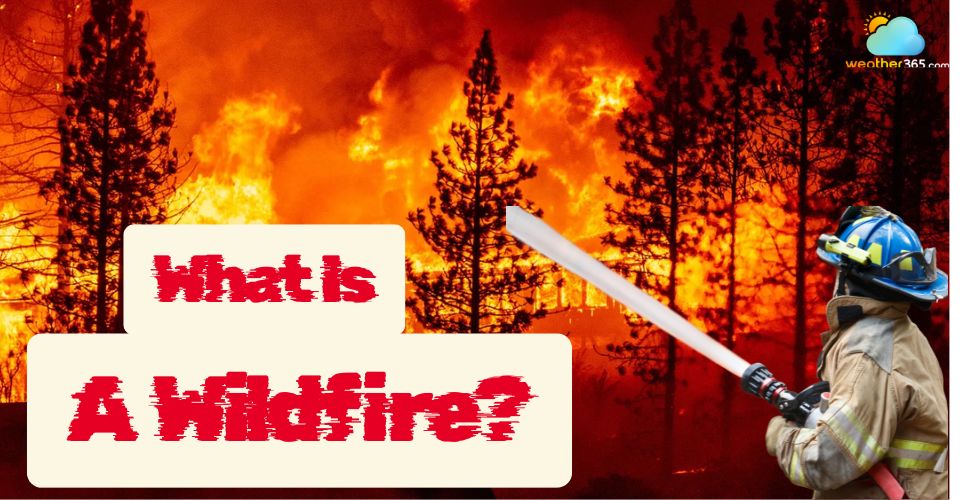
Definition of wildfire event
What is a wildfire?
A wildfire is a large, uncontrolled outdoor fire that primarily burns vegetation in wildland or rural areas. It can also spread into nearby communities, threatening structures and infrastructure.
Wildfires are not limited to a particular area or environment. They can start in forests, grasslands, savannas, and other ecosystems.
Moreover, wildfires can burn grass and plants in and above the soil.
Another common term is bushfire; however, wildfire is broader than bushfire. You can explore the difference between wildfire and bushfire at Weather365.
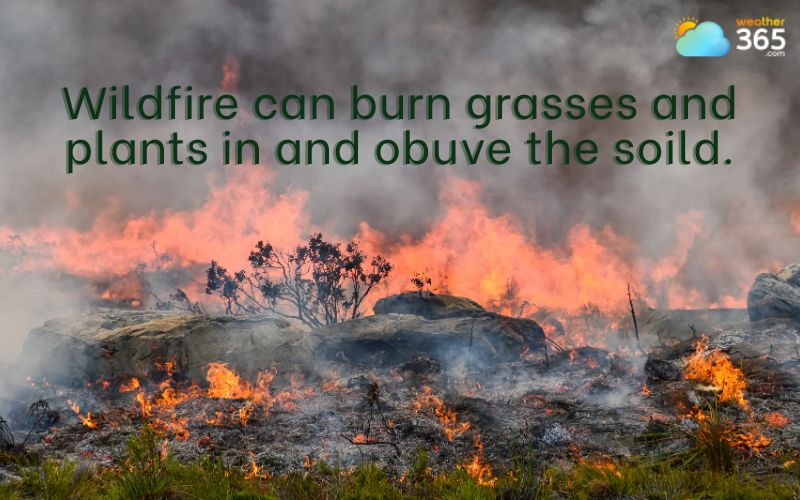
Definition of a wildfire
Key characteristics of a wildfire
Wildfires are more frequent and intense. Here are the key characteristics of a wildfire that make it so powerful and sometimes unpredictable:
👉 SPEED: Wildfires spread rapidly, burning brush, trees, and even homes in their path within a short time. Grassfires' speed can reach up to 22km/h (14mph) or in extreme cases, the speed can be over 22km/h.
👉 TEMPERATURE: Flames can reach temperatures over 2,000°F (1,093°C), causing immediate destruction to vegetation and wildlife and making firefighting extremely dangerous.
👉 IMPACT: Wildfires can burn anything from a few acres to entire regions, leaving behind significant ecological damage and economic losses.
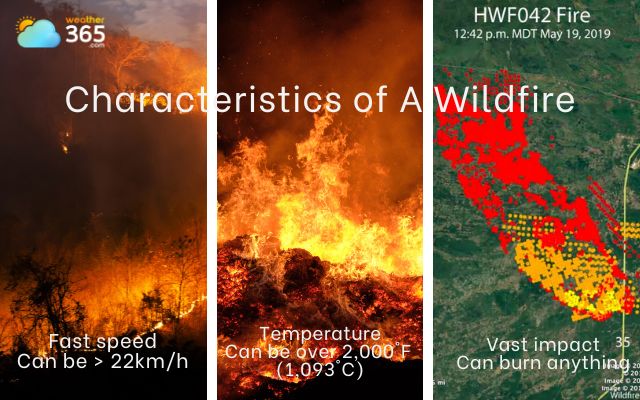
Characteristics of wildfires
Wildfire behavior depends on factors like tree canopy, organic matter, and fire type.
Dense canopies can fuel intense crown fires, while fallen leaves and branches feed surface fires that may lead to larger events.
Understanding surface, crown, and ground fires is crucial, as each spreads differently and requires specific containment strategies.
Types of wildfires
There are 3 types of wildfires: surface fires, crown fires, and ground fires.
This category is based on where and how they burn.
Each type has unique characteristics, and we need to conduct different firefighting efforts.
Take a look at this comparison table.
|
Type of Wildfire |
Surface Fire |
Crown Fire |
Ground Fire |
|
Location of Fire |
Forest floor, grass, shrubs, and low vegetation |
Tops of trees (tree canopies) |
Beneath the surface, in soil and root layers |
|
Characteristics |
Most common type; spreads along the ground; easier to control than other types. |
Extremely intense; spreads rapidly, often driven by strong winds and dry conditions. |
Slow-moving; can smolder for long periods, often undetected. |
|
Impact |
Burns vegetation, can transition to crown fires under certain conditions. |
Very destructive; difficult to control; threatens wildlife, property, and infrastructure. |
Damages soil structure, releases significant carbon, hard to extinguish. |
Are wildfires natural?
What is the cause of a wildfire? People often think about natural reasons.
Both natural and human factors can cause wildfires.
In most wildland areas, wildfires are part of a natural cycle. Historically, low-intensity fires would burn periodically. These fires clear out excess vegetation, prevent massive fuel buildup, and even enrich the soil to support ecosystem renewal.
However, human intervention has disrupted this balance. Researchers call it the “fire paradox.”
The fire paradox occurs when people attempt to put out and suppress wildfires of any kind, but doing so can result in fuel accumulation. When a fire eventually ignites, it has far more fuel to consume, often resulting in large, intense wildfires that are much harder to control.
Wildfires are sparked naturally, typically by lightning. The majority of today are caused by human activity and are considered unnatural.
Interestingly, many Indigenous groups in North America used controlled burning for centuries as a sustainable land management tool. “These groups were able to do this sustainably for a long period, which could allow these fires to be referred to as natural,” explains James Urban, Assistant Professor of Fire Protection Engineering at WPI.
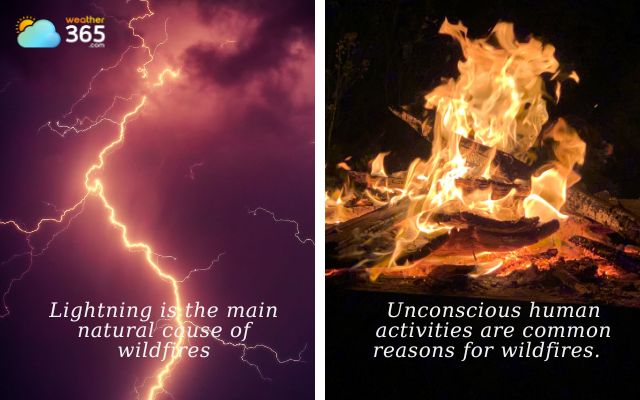
What causes wildfires?
Where Do Wildfires Occur?
Wildfire hotspots are regions where the risk of wildfires is exceptionally high due to a combination of climate, vegetation, and weather patterns.
These areas often experience high temperatures, prolonged dry conditions, and strong winds. It creates perfect conditions for fires to ignite and spread rapidly.
What country has the most wildfires?
Some of the world’s most notable wildfire hotspots include the Mediterranean Basin, parts of Australia, the Western United States, and the Amazon rainforest.
Each region faces unique wildfire management challenges influenced by its environmental conditions and human activities that heighten fire risk.
In places like California and Australia, wildfires are almost an annual occurrence. Long, hot summers with little rainfall are often followed by dry autumns, leaving vegetation parched and highly combustible, which regularly trigger massive fire outbreaks.
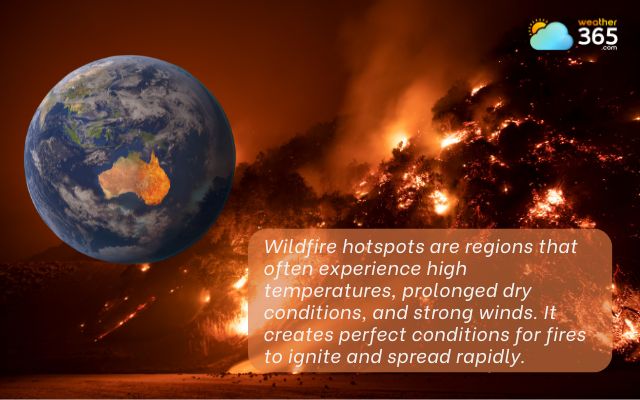
Wildfire hotspots around the world
Climate change is further intensifying wildfire risks worldwide. Rising global temperatures, extended droughts, and shifting rainfall patterns are creating drier landscapes and more flammable vegetation, even in areas previously less vulnerable.
This shift is increasing both the frequency and severity of wildfires while expanding the geographical range of wildfire-prone regions.
Ecosystems, wildlife, and communities are under growing threat.
Therefore, it's essential to have comprehensive strategies for prevention, mitigation, and adaptation.
You may also like this: What States Have the Most Wildfires?
Are wildfires more and more frequent?
The number of wildfires isn’t increasing, but the total area burned by wildfires is growing.
The reason is that today’s wildfires tend to be more intense and destructive, causing greater ecological and economic damage. In other words, it’s not just how many fires occur, but how many are high-impact events.
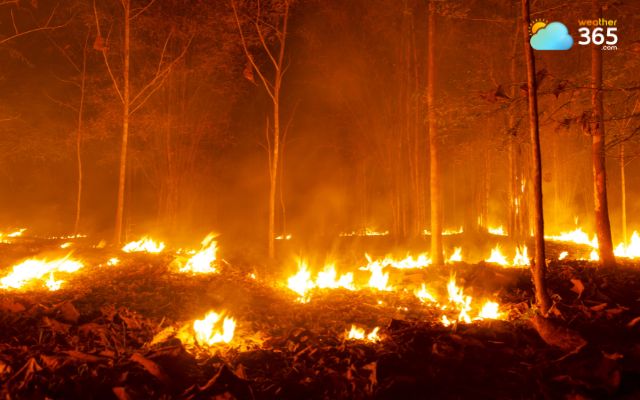
Are wildfires increasing?
This impact is further amplified as more people move into wildland-urban interface (WUI) areas.
Human presence in these regions increases the likelihood of ignitions from everyday activities, leading to a higher risk of damaging fires.
So, How to prevent wildfire? Read our previous article.
Do wildfires cause cancer?
Wildfire smoke health effects are serious.
Wildfires release harmful air pollutants, including PM2.5. These microscopic particles, made up of soot and unburned fuel, can penetrate deep into the lungs and bloodstream, increasing the risk of cancer and other serious health issues.
The impacts of wildfires extend far beyond health.
Entire communities, homes, and ecosystems can be destroyed in a single event.
Wildlife may abandon burned areas for years, causing long-term ecological disruption.
To reduce exposure to wildfire smoke, experts recommend wildfire safety tips such as:
-
Stay Informed: Monitor local alerts and evacuation orders.
-
Prepare an Emergency Kit: Include water, food, masks, and important documents.
-
Create Defensible Space: Clear dry leaves, branches, and flammable items around your home.
-
Use Fire-Resistant Materials: When possible, upgrade roofing and siding.
-
Have an Evacuation Plan: Know multiple routes and practice with family members.
-
Protect Indoor Air: Use air purifiers and keep windows closed during smoke events.
-
Wear N95 Masks: When outdoors in smoky conditions.
-
Avoid Outdoor Flames: Don’t burn debris or use fireworks during dry, high-risk periods.
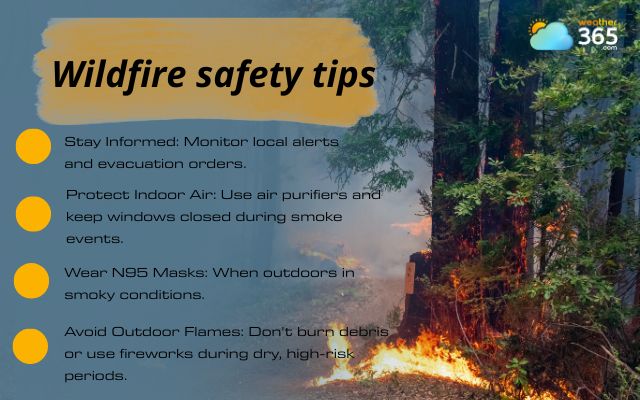
Wildfire safety tips
Conclusion
Wildfires not only destroy forests and infrastructure but also impact public health, wildfire devastation, and climate change. Understanding what is a wildfire, the types of wildfires, and their causes is crucial to mitigate their devastating effects.
Frequently Asked Questions (FAQs)
Related post
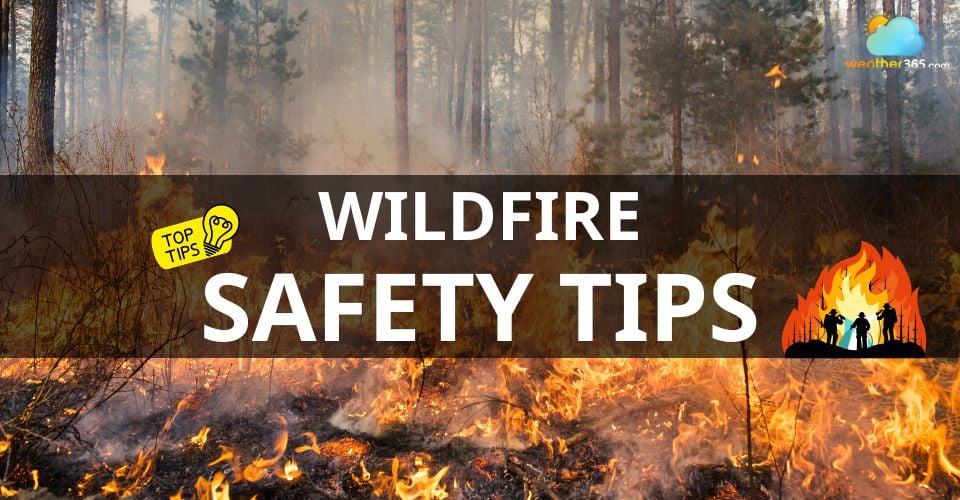
Wildfire safety tips: What to do BEFORE - DURING - AFTER a wildfire
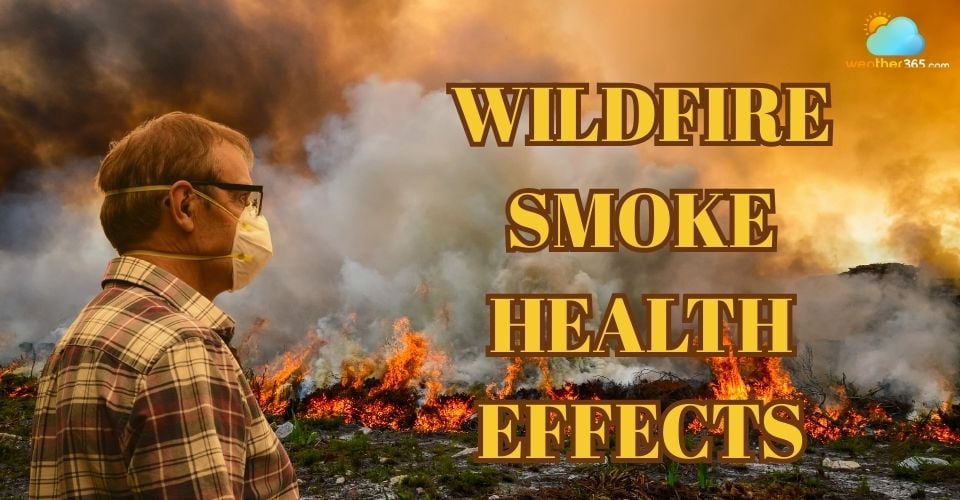

0 Comment
Leave a comment
Your email address will not be published. Required fields are marked *